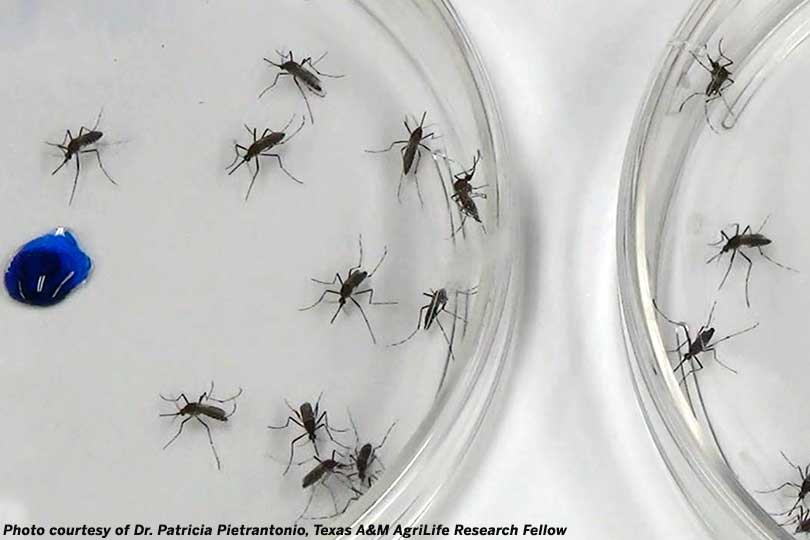By Steve Byrns
AgriLife Today
COLLEGE STATION—Major rainfall across most of Texas triggering hordes of mosquitos coupled with seemingly constant mosquito-related Zika virus media reports from around the globe may have set the stage perfectly for what one researcher deems as a very significant discovery in man’s war against earth’s leading human disease carrier.
Dr. David Ragsdale, head of the entomology department at Texas A&M University, College Station, credits Dr. Patricia Pietrantonio, a Texas A&M AgriLife Research Fellow in the entomology department at College Station, along with her students and colleagues from other institutions, with discovering a receptor on the legs of mosquitoes that when activated, keeps female mosquitoes from taking a sugar meal and makes them fly away.
“This finding could lead to novel mosquito repellents,” Ragsdale said. “This is really a big deal, a major achievement.”
Ragsdale said Pietrantonio has just had the article, “Leucokinin mimetic elicits aversive behavior in mosquito Aedes aegypti (L.) and inhibits the sugar taste neuron,” on the work published in the Proceedings of the National Academy of Sciences. To view the work and its authors go to http://www.pnas.org/content/early/2016/06/01/1520404113.abstract.
“What makes this even more compelling is the work was with Aedes aegypti, the mosquito species responsible for spreading Zika, dengue, yellow fever and Chikungunya viruses,” Ragsdale said. “This work is the culmination of over five years of study by Dr. Pietrantonio, her students and collaborators. With Zika a looming threat, this is a timely discovery.”
Pietrantonio said after mating, Aedes aegypti females immediately search for a blood meal from a human host.
“They are highly anthropophilic, meaning they are attracted to humans,” Pietrantonio said. “They may even follow people indoors. If female mosquitoes are infected with viruses they may transmit them to humans when they acquire a blood meal.”
The blood meal supplies the protein source female mosquitoes require to produce eggs, she said.
“However, in the field, if human hosts are not present, females will feed on sucrose solutions such as nectar from flowers, though they prefer a blood meal to a sugar meal but male mosquitoes feed only on nectar. Certainly sugar feeding is one of the two feeding modalities for adults of this species.”
“We found that a synthetic peptide that was designed to mimic a peptide naturally present in mosquitoes triggers an aversive fly away, walk away or jump away behavior in female mosquitoes.”
If the same aversion could be tied to a blood meal, she said a totally new and effective mosquito feeding deterrent may be in the offing, one that perhaps would cause the mosquito to pass up the required blood meal needed to lay eggs. Doing so would either disrupt the life cycle and/or reduce disease transmission.
However, this is far from being accomplished, she said.
“One of our team designed a peptide mimetic of the kinin peptides, which are diuretic hormones in mosquitoes, to be resistant to enzymatic degradation,” Pietrantonio said. “These mimetics are more potent than those found naturally, because they take longer to be degraded by the insect. These diuretic hormones make mosquitoes lose water after a blood meal, but we also found the peptidomimetic blocked sugar perception. This is a completely new and unexpected discovery.”
The research team localized these receptors in the feet and mouth parts of mosquitoes. What is really new, they said, is that this type of receptor proteins, known as GPCRs, were not previously considered to be important for “taste” in insects and further, contact with the peptidomimetic made the mosquitoes fly away.
“In sum, we unequivocally verified this kinin receptor is present in the taste organs of the legs and labella, the pair of lobes at the tip of the proboscis.”
Pietrantonio said their observation that the peptide blocks sugar perception is interesting because the peptide is insect-specific, therefore, the receptor represents a target for further applied research to find ways to diminish the ability of female mosquitoes to feed. Doing so would likely

